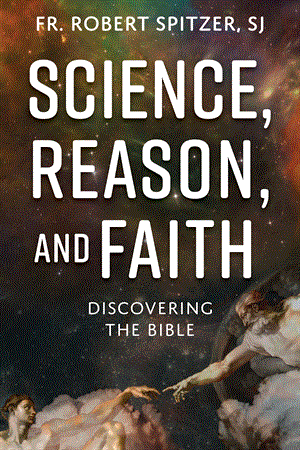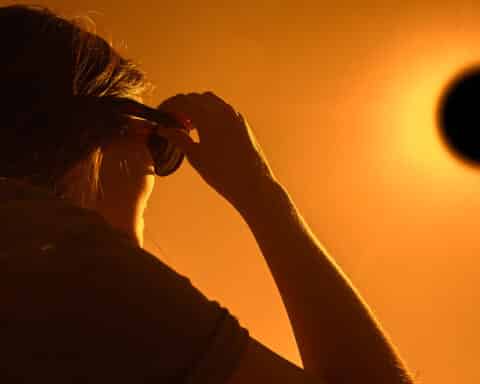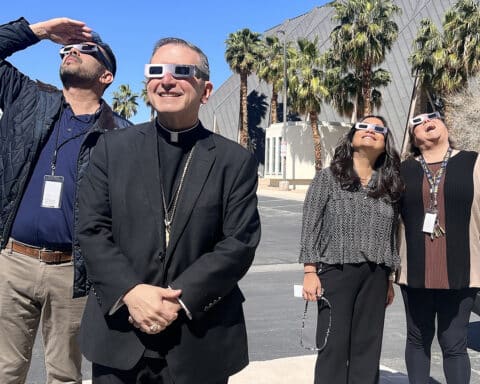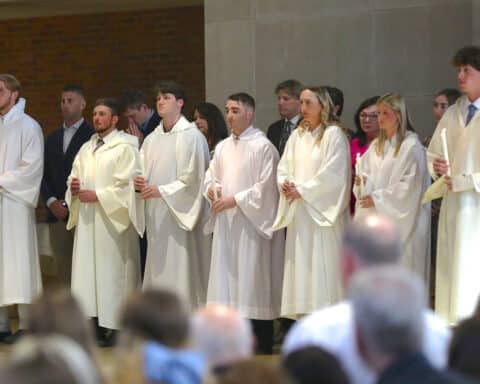There is a moment right after you’ve passed outside of our galaxy when, all of a sudden, the darkness of space fills with uncountable new points of light. What you see looks like a very full night sky on Earth, with every star shining. But these aren’t stars that you see — at least not singular stars. As the planetarium’s narrator reveals, “each dot you see now is a galaxy made up of many billions of stars.” Thousands of dots, each containing billions of stars. This leap in the order of magnitude is nearly impossible to fathom. Your imagination trembles. This is the moment when the immensity of your smallness causes you to audibly gasp.
I have witnessed that gasp for more than 17 years now. It happens in the middle of the 50-minute planetarium presentation called “All Creation Gives Praise” that I co-created with my astronomer colleague, Phil Sakimoto, in Notre Dame’s Digital Visualization Theater.
This partnership started when I myself first glimpsed the expanse of our observable universe under Phil’s guidance within this dome-shaped theater. I myself gasped when we made the jump from seeing stars to seeing galaxies that looked like stars. I also gasped when I saw the microwave radiation from the Big Bang, originating some 13.8 billion light years away. I gasped again when we returned to our own planet after seeing the tremendous distances between everything else.
Since that experience, we have been working to help people understand what they are able to see from this planetarium space, while also offering them the opportunity to praise the God who creates and governs it all — the God who fills our gasps of wonder with his love.
Rekindling wonder
Wonder is hard to come by these days. Our media producers and content creators have become so proficient at grabbing our attention that we find it harder and harder to stay focused on one thing for very long. Wonder takes time; it is more than surprise and interruption. Wonder is a relationship of intimacy, where you find yourself in awe at something that is beyond you, which becomes more fascinating the longer you dwell with it.
68% of Americans say there is no conflict between their personal religious beliefs and science, according to a 2015 study by the Pew Research Center.
In his great book about the necessity of detachment and solitude for true human life, Cardinal Robert Sarah in his book “The Power of Silence” (Ignatius, $18.95) does not mince words when he diagnoses our modern media ecology: “Images are drugs that we can no longer do without because they are present everywhere and at every moment. Our eyes are sick, intoxicated, they can no longer close. It is necessary to stop one’s ears, too, because there are sonic images that assault and violate our sense of hearing, our intellect, and our imagination.”
Wonder is a relationship of intimacy, where you find yourself in awe at something that is beyond you, which becomes more fascinating the longer you dwell with it.
Cardinal Sarah is not advocating for entering into sensory deprivation chambers where we try (in vain) to shut off all observing, thinking and reflecting. Rather, he is naming what many people instinctively feel: There is no time or space today in which we can truly focus, ponder and contemplate — everything is coming at us so fast; we are incessantly bombarded with stimuli. The vast majority of us are far from the regular life experience of someone like the 18th-century Congregationalist preacher, Jonathan Edwards, who wrote in his “Spiritual Exercises” that “I spent most of my time in thinking of divine things, year after year, often walking in the woods, and solitary places, for meditation, soliloquy, and prayer, and converse with God. … Prayer seemed to be natural to me, as the breath by which the inward burnings of my heart had vent.”
Edwards lauds the communicative capacity of nature while Cardinal Sarah laments the suffocating effect of too many artificial images. We feel the difference between the two if we find ourselves on a mountain’s peak, or deep in the woods, or surrounded on all sides by rolling prairies. It is not that the Wind River Range of Wyoming is intrinsically “better” nature than that of Lower Manhattan; rather, it is that Lower Manhattan has become a setting suffused with busyness, electronic communication and artificial images, while the backcountry of Wyoming is outside the reach of technological, commercial and industrial ways. You are more likely to be overwhelmed with man-made images in Manhattan and overcome by natural ones in Wyoming.
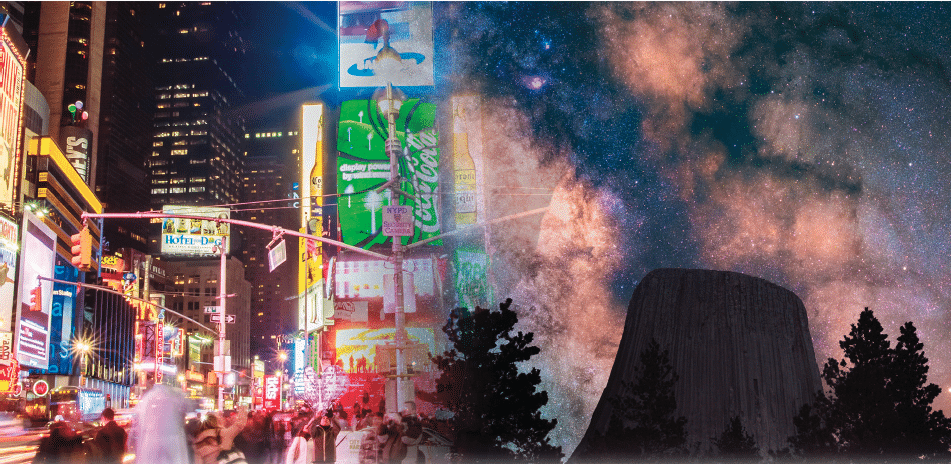
Don’t be a fool; open your senses
The “Creator of heaven and earth” is not absent from Lower Manhattan — far from it. Instead, those who have grown accustomed to such places are more likely to become desensitized to the traces and signs of God when saturated by all the busyness. This may be just as true today in one’s own living room where screens and notifications vie for attention in every passing moment.
Long before the industrial or digital revolutions, St. Bonaventure spoke to the perils of constant distractedness and the need to be awakened again to the Word of God, who is the principle of all life. He wrote: “Whoever, therefore, is not enlightened by such splendor of created things is blind; whoever is not awakened by such outcries is deaf; whoever does not praise God because of all these effects is dumb; whoever does not discover the First Principle from such clear signs is a fool. Therefore, open your eyes, alert the ears of your spirit, open your lips and apply your heart so that in all creatures you may see, hear, praise, love and worship, glorify and honor your God” (“The Journey of the Soul into God”).
The paradox Bonaventure notices is that our senses must be opened to recognize God in created things. It would seem that our senses are quite open when perpetually attending to all the many images, sounds and parcels of communication that surround us today. But the truth is that our senses are dulled by such things, so that true sensing is obstructed and ultimately snuffed out by these forms of sensory overload, the same way too much cotton candy ruins an otherwise healthy appetite. This is what Edmund Pevensie infamously learned in “The Lion, the Witch and the Wardrobe” when he had eaten too much enchanted Turkish Delight: “there’s nothing that spoils the taste of good ordinary food half so much as the memory of bad magic food.” Artificial images employed to steal our attention are the bad magic food; natural images are the good ordinary food.
Retreating to outer space
Weeks spent “off the grid” in a natural environment without artificial stimulation can restore the appetite and open the senses again. So can a disciplined pilgrimage, such as on the Camino de Santiago, or even a monastic immersion experience. We can retreat to the desert, retreat to the woods, or retreat to sea. But we couldn’t possibly retreat to outer space, could we? Even those very few astronauts or billionaires who make it to space only make it to near space, barely even outside the Earth’s atmosphere, or at most 250,000 miles away on our moon. The deep reaches of space are, indeed, out of reach. But what if they weren’t?
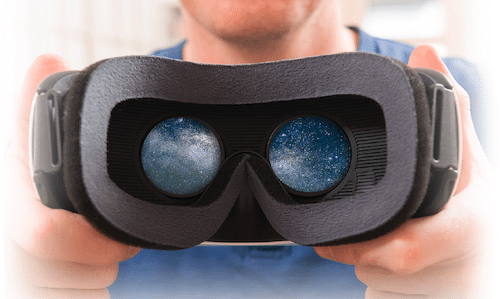
While the boundaries of physics prevent us from moving our bodies beyond, at most, our planet’s immediate neighborhood, by using technology well we can now place our attention on those places and things to which we cannot move otherwise. Were we to do that with an array of artificial images and fabricated experiences, however, we would be doing nothing other than exchanging one trick of media saturation for another. But if we were able to observe the real imagery that our technological means brought to us, we would instead be doing something akin to reading a map in three-dimensional space. Only in that way could the far reaches of the cosmos become a setting for a retreat into nature like the other retreat destinations.
The premise on which “All Creation Gives Praise” relies is just this: to only present real astronomical observations so as to provide an immersive natural environment for rekindling wonder. The technology employed extends the power of our eye through satellite imagery; it then orders and organizes what has been observed and gives the participants the experience of moving through these cosmological realities sequentially and proportionally in a domed theater. What participants experience are “views of what you would see if you really could travel through space.” The possibility of encountering something truly new and literally breathtaking is, as the astronomical narration announces, “not science fiction, but science fact.”
Science and religion
Seeing is not believing, but belief does need sight. We move toward belief in what we cannot or have not yet seen on the basis of that which we have seen. True, the Lord said to St. Thomas that “Blessed are those who have not seen and have believed” (Jn 20:29). But immediately afterward, St. John the Evangelist writes that these signs “are written that you may [come to] believe that Jesus is the Messiah, the Son of God” (Jn 20:31). In other words, St. Thomas saw the glorified risen body of his Lord, while all other disciples after him must rely on the signs recorded in the Gospel so as to make the act of belief in that same Lord. We see signs and then, on the basis of the signs we have seen, are invited to believe in the one to whom the signs point.
30% of Americans see a conflict between science and their religious beliefs; the most common source of disagreement involves beliefs about evolution and the creation of the universe.
The way in which science and religion are related to one another in “All Creation Gives Praise” is analogous to the relationship between signs of the Incarnate Word and belief in him. What we explore is what astronomers have called “the observable universe” — meaning all that has been observed through astronomical means. The sky is too vast and the distances too enormous to observe everything, so by international concord astronomers have agreed to scan and map the sky in certain directions, accounting for everything they can detect and analyze. By scientific reasoning, astronomers seek to identify and understand that which is perceptible. “All Creation Gives Praise” makes use of these observations, the things we can perceive. The aim of the astronomical part of the presentation is to help participants grow in knowledge and understanding of what we human beings have observed in space.
The role of theological reflection, then, is first to marvel at that which we see through the words of Scripture and Tradition, and then to prompt us toward the possibility of greater belief. What we see are signs of the Word of God, by whom and through whom all things are made. Once we begin to understand what we are seeing, the grammar and longing of the language of faith open a path that leads from astonishment to prayer.
A surprising gift of being able to see and move through the observable universe is that it reveals the inner beauty of the Word of God in ways that may have been previously unascertainable. We might consider, for example, the moment in the journey mentioned above, where we depart from the Milky Way galaxy and begin to see the light of innumerable whole galaxies filling our field of vision. The astronomical narration leads us to better understand what we are now seeing, as galaxies are shaded with different colors for an educational purpose:
“Each dot you see now is not a star. Each dot is a galaxy made up of many billions of stars. Galaxies of the same color are bound together into a cluster, held together by their mutual gravitational attraction. Notice that the clusters are not randomly distributed in space. Instead, they tend to lie along long filaments. These filamentary structures are places where there is more gravitational attraction than in other places. We do not know what causes this extra gravitational attraction, but we do know that whatever it is emits no light. It is dark. Therefore, we call it ‘Dark Matter.’
“While gravity, aided by Dark Matter, holds clusters of galaxies together, we also observe that each cluster is moving away from every other cluster. The entire universe is expanding and taking the clusters of galaxies with it. … In recent years, we have discovered, again through observations, that the rate at which the universe is expanding is speeding up. We do not know what is causing this acceleration. We do know that it is an energy that pervades all space, and we know that we cannot see it: it gives off no light. So we call it ‘Dark Energy.'”
A union of faith and reason
When the astronomical narration then ceases, the narrative of faith resumes, all while participants continue to gaze at the increasing number of clustered galaxies as we drift farther away from the Milky Way. Whereas the astronomical narration addresses each listener as a guide addresses a first-time traveler to a new land, the faith narration is offered in the first-person voice, so that each participant may take up this voice as their own. Notice how the words of the psalms and even a line from a saint allow each traveler to speak into this moment of wonder:
“I am still tempted to think there are places You do not know, Lord, where my boldness will escape your safety. But ‘if I say, surely darkness will conceal me, night will provide me with cover; you reveal that darkness is not dark for You, night is as light as day; darkness and light are the same’ [cf. Ps 139:11-12]. ‘You are clothed in glory and majesty, wrapped in a robe of light; you spread the heavens like a tent cloth’ [cf. Ps 104:1-2]. And in the gentle mirror of your glory [St. Catherine of Siena, “The Dialogue”], ‘I see that I am wonderfully made’ [cf. Ps 139:14]. Help me entrust myself to your glory.”
And so the entire presentation is a living experience of the dialogue of science and religion, faith and reason, astronomy and theology. We strive to see and understand better, so as to pray and praise more deeply, honestly, and boldly. Science remains science and religion remains religion — yet by speaking together in a mutually hospitable manner, something new emerges: a union of faith and reason.
Science remains science and religion remains religion — yet by speaking together in a mutually hospitable manner, something new emerges: a union of faith and reason.
As one professional astronomer said after experiencing this presentation: “I learned to see that the absence of space is actually filled with the love of God.” And as this theologian said upon my own experience of moving through the cosmos in wonder and prayer: “I learned to see that God’s love for us is not in response to any kind cosmic significance we have; it is all about the intensity of his attention. I rediscovered the meaning of the Eucharist in space.”
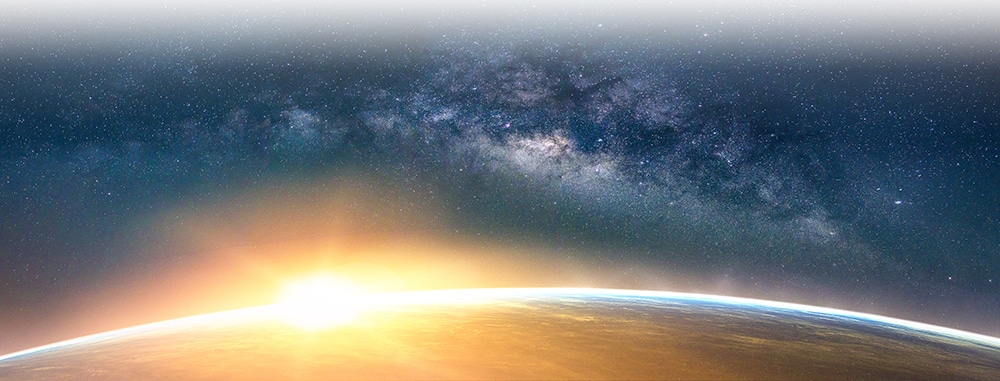
Why we matter
The psalmist could see no farther than his naked eye would take him, and yet he stood agape before the night sky and exhaled his awe: “When I see your heavens, the work of your fingers, / the moon and stars that you set in place — / What is man that you are mindful of him, / and a son of man that you care for him? / Yet you have made him little less than a god, / crowned him with glory and honor” (Ps 8:4-6).
The effect of moving with our attention to the most distant reaches of the observable universe is returning to our given place, in our particular time, to discover ourselves … small, seemingly insignificant, a speck of dust in a breath of time thrown amidst the vastness of creation. Seeing this truth upends our illusions about ourselves and our delusions about God. We are not the center of the universe: by this journey, we can see that clearly. From beyond about 100 light years away, there is not only no trace of our existence but, also, there would be no way to detect our presence. (That’s because about 100 light years is about how far our radio and television signals have traveled out into space, giving evidence of our existence.) Everything we have ever known is contained within an indescribably small bubble of cosmic space, with potentially infinite more space on every side. Cosmically speaking, we just don’t matter.
Cosmically speaking, we just don’t matter. But we matter to God.
But we matter to God. To us, the Father has sent his Son. To become one with us, the Word became flesh. For us, God gives himself. We can see everything there ever was and ever will be, but all of it is for nothing if we do not move from seeing the magnificent “sign” of creation itself to believing that the meaning of heaven and earth was once contained in the little space of Mary’s womb. The fullness and intensity of the Lord of the cosmos — through whom, with whom, and in whom all that is, is — is made present to us under the appearance of simple bread and wine of the altar. Everything that exists serves as the backdrop for that which is most wonderful and surprising of all: God comes to us.
Left to our own power, “the infinity of space and time separates us from God,” writes Simone Weil. “How are we to seek him? How are we to go toward him? … We are incapable of progressing vertically. We cannot take a step toward heaven. … [Instead,] God crosses the universe and comes to us … [and] over the infinity of space and time, the infinitely more infinite love of God comes to possess us” (“Waiting for God”).
| Science, Reason and Faith |
|---|
|
This yearning for truth ultimately leads us to our Creator. God knows the longings of the human heart, and he reveals himself to us through creation, through Scripture, and ultimately through the Incarnation. Because God the Son became man, we have a person to look to in our pursuit of truth: Jesus Christ himself, who is Truth. Christ helps us see that truth is not just the object of science and reason, but what animates the mysterious and loving power of faith. In “Science, Reason, and Faith” ($34.95), Father Robert Spitzer, SJ, explores in depth the Bible and the intersection of three realms that the secular world tells us are separate and incompatible. Father Spitzer draws the modern reader’s attention to the many seeming conflicts between science, reason and Catholic teaching. By tackling these difficult questions, he shows that it is precisely through the integration of science, reason and faith that we can truly discover ourselves, our world and our God. Get your copy at osvcatholicbookstore.com. |
God comes to us so we may go to him. That is the meaning of all existence. The Incarnation is the descending movement, the Ascension the movement that opens way for our own ascent. A journey through the cosmos shows us that no matter how far we go on our own, we will never reach fulfillment and peace unless we accept the mercy of a God who comes to us.
“All Creation Gives Praise” is a privileged journey, one at the intersection of faith and reason, one that can open up new dimensions of prayer, longing and gratitude. Yet what is truly necessary is not reserved for those with the power of astronomical observations, a high-tech planetarium, or even critical thinking skills. All these can be of use. But the truly necessary thing is to make our own space of creation into a place of praise, beginning and ending with the offering of the Eucharist.


